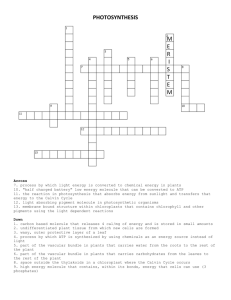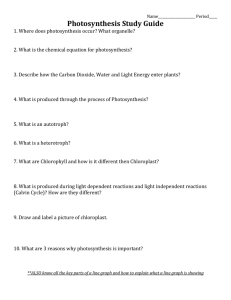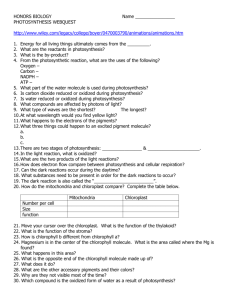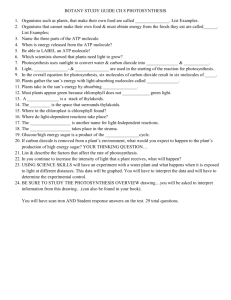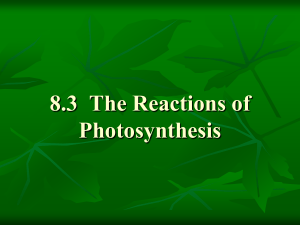Photosynthesis
advertisement
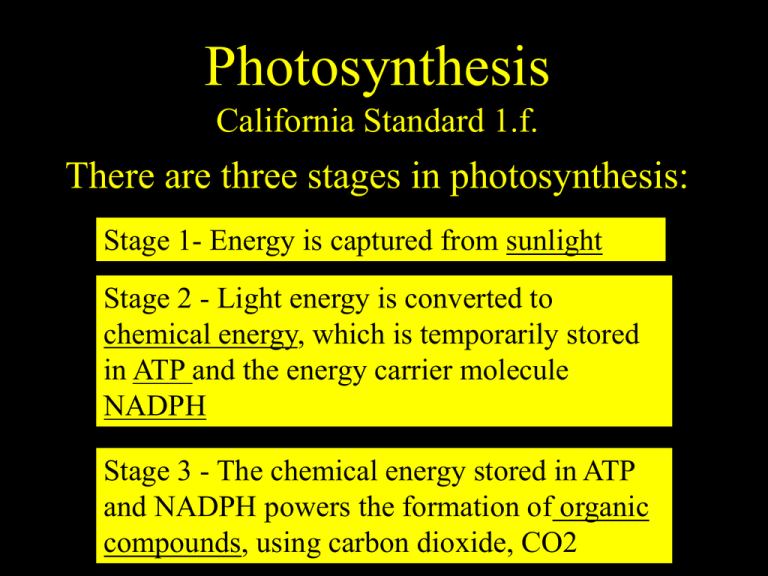
Photosynthesis California Standard 1.f. There are three stages in photosynthesis: Stage 1- Energy is captured from sunlight Stage 2 - Light energy is converted to chemical energy, which is temporarily stored in ATP and the energy carrier molecule NADPH Stage 3 - The chemical energy stored in ATP and NADPH powers the formation of organic compounds, using carbon dioxide, CO2 The chemical reactions that occur in the first and second stages of photosynthesis are called the “light reactions” while the third stage is called the “dark reaction”. Stage 1: Energy is captured from sunlight. We have talked about the chlorophyll molecule so far. However, there are two types of chlorophyll molecule; chlorophyll a and b. There are also a second type of pigment molecules. They are called carotenoids. These pigments are responsible for the yellow and orange colors we see in the fall and for the yellow and red fruits and vegetables we see at the grocery. Carotinoids absorb wavelengths of light that are different from those of chlorophyll. Therefore, the plants can absorb more light energy during photosynthesis. and carotinoid pigments Molecular make up of Chlorophyll a and b The electrons that leave the thylakoid membrane are replaced by the electrons from the splitting of the water molecule into H and O ions. The oxygen molecule from the water is then released into the environment for us to breathe. Remember: 1) Chlorophyll is the molecule which is the pigment that captures the energy from sunlight. This energy causes the water molecule to ‘split’ releasing an electron. It is the chlorophyll molecule which causes the leaf to look green. 2) The transfer of electrons from water takes place in the thylakoid membrane and this is where oxygen is released. 3) The granna are stacks of thylakoids in the chloroplast organelle. 4) The chloroplast is the organelle which you can see under the microscope and which is responsible for photosynthesis. Chloroplast with stroma, thylakoid and granum. Chloroplast is the organelle which captures sunlight and turns it into carbohydrates and energy. Chloroplast organelle Stacks of granna Oh… thank you Lord… now I understand!!! But I still think Mr. Post is wacked.! Stage 2: Light energy is converted to chemical energy There are two types of electron transport chains both occur in the thylakoid membrane. 1. The first type is one that produces ATP from ADP. 2. The second is the one that produces NADPH from NADP+. The first gains or loses a P molecule while the second gains or loses a H ion. Both of these energy molecules are used in the third stage of photosynthesis. We have covered the first two stages of photosynthesis. They are both called the light-dependent stages. The light-dependent stages can be summarized as follows: 1. Pigments in thylakoids absorb light 2. The electrons that are excited by light move through the electron transport chains in thylakoid membranes 3. These electrons are replaced by electrons from the water molecule, which is split by an enzyme. 4. Oxygen atoms from water form to create oxygen we breathe. 5. H ions accumulate inside thylakoids that supply the energy to make ATP and NADPH Stage 3: Energy is stored in organic compounds The transfer of carbon dioxide from the atmosphere to organic compounds is called carbon dioxide fixation. This process is independent of light, therefore it is know as the “dark reactions” or light-independent reactions of photosynthesis. The general process of photosynthesis involves 3 molecules of carbon dioxide with 3 molecules of water to form a 3-carbon sugar and oxygen gas. The reactants are carbon dioxide and water to form the products: carbohydrates (starch) and oxygen gas. 3H2O + 3CO2 ----------> C3H6O3+ 3O2 The oxygen we breath comes from the molecule water. The most common means by which CO2 is fixed is through the Calvin Cycle. However, there are other means to fix Carbon but this is the one we will study. If you did not know, the Calvin Cycle was named after Melvin Calvin who discovered this means of CO2 fixation while a professor of chemistry at University of California at Berkeley in 1947 using Carbon 14. He received a Noble Prize for his discovery in 1961 and died in 1997. Dr. Melvin Calvin is shown below in his “mad” scientist lab at UC Berkeley, circa 1952. Just remember ‘C’ stands for carbon dioxide fixation and ‘C’ is the first letter in Calvin Cycle that is the process that fixes Carbon and produces Carbohydrates. Get it? C for Carbon, C for Calvin and C for carbohydrates. Or put another way… C-C-C. Get it? FORGET IT! The Calvin Cycle: end result is a 3 carbon sugar (3 Ribulose 1,5 bisphosphate) Points to remember about the Calvin Cycle: 1. It is one means to fix CO2 2. Energy from ATP and NADPH are used which came originally from photosynthesis. 3. It is one means of making organic compounds by plants which are later used by animals; that is you and me. Factors that affect photosynthesis: 1) Light intensity until all pigments are saturated, 2) level of CO2 concentration until saturation occurs, 3) temperature ranges due to enzyme activity. The beginning and the end of photosynthesis The End Mr. Post having a bad hair day.
